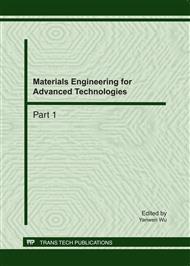p.453
p.459
p.466
p.472
p.478
p.484
p.490
p.496
p.502
Py-GC/MS Analysis of Bioactive Components of 550°C Pyrolyzate from Acetone Extractives of Cinnamomum camphora Root Wood
Abstract:
The researches are very less about the acetone extractives of rood wood from Cinnamomum camphora, a famous non-wood tree in China. Therefore, 550°C-based Py-GC/MS was used to analyze the high-grade resource recovering approaches of C. camphora root wood. The analytical result showed that the main components of the acetone extractives of C. camphora root wood by 550°C-based pyrolysis- GC/MS are as: Decanoic acid, 1,2,3-propanetriyl ester (16.720%), 4-Nitrophenyl laurate (9.104%), 1,3-Benzodioxole, 5-(2-propenyl)- (6.3744%), Bicyclo[2.2.1]heptan-2-one, 1,7,7-trimethyl-, (1R)- (5.646%), 2-Hydroxy-5-methylbenzohydrazide (3.516%), p-menth-1-en-8-ol (3.279%), Benzene, 1,2-dimethoxy-4-(2-propenyl)- (2.686%), Dodecanoic acid, 1,2,3-propanetriyl ester (2.478%), 2,3-Butanediol, [S-(R*,R*)]- (2.177%), Phenol, 2,6-dimethoxy- (2.147%), 2-Oxabicyclo[2.2.2]octan-6-ol, 1,3,3-trimethyl- (1.642%), Tricyclo [2.2.1.0(2,6)]heptane, 1,7-dimethyl-7-(4-methyl-3-pentenyl)-, (-)- (1.349%), Bicyclo[2.2.1] heptan-2-ol, 1,7,7-trimethyl-, (1S-endo)- (1.292%), Acetic acid, 2-acetoxymethyl-1,2,3- trimethylbutyl ester (1.174%), Phenol, 2,6-dimethoxy-4-(2-propenyl)- (1.125%), etc. The result of functional analysis suggested that C. camphora root wood can be used as top value-added materials of biomedicine, and also as the materials of bioenergy, perfume, cosmetic, food, dye and industrial solvent.
Info:
Periodical:
Pages:
478-483
Citation:
Online since:
June 2011
Authors:
Price:
Сopyright:
© 2011 Trans Tech Publications Ltd. All Rights Reserved
Share:
Citation:


